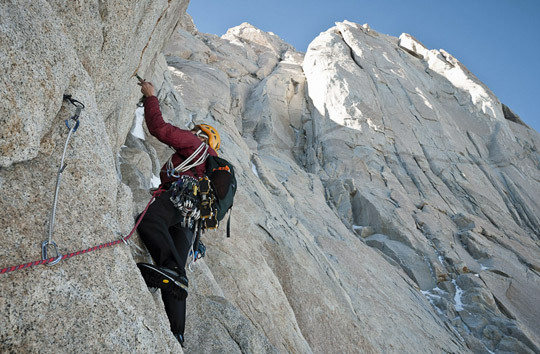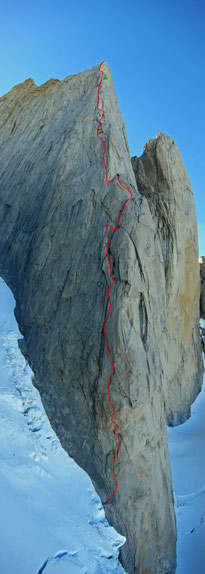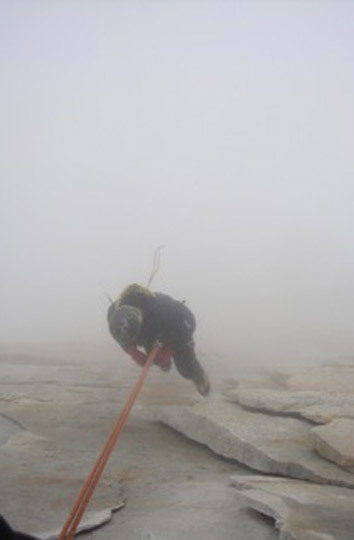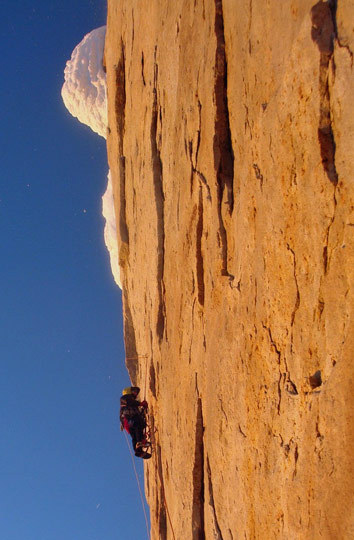
Cerro Torre Massif, Argentine Patagonia. Recently, some unexpectedly long weather windows released a flood of climbers into Los Glaciares National Park. [Photo] Neil Kauffman
Recently, two weather windows afforded a gathering of climbers in Patagonia the chance to tackle numerous objectives in the Fitz Roy, Pollone and Cerro Torre Massifs. In early February, teams put up a variety of first ascents, FFAs, significant attempts and variations. “Apparently the weather would stay good for several more days, which had compelled some folks to wait and plan bigger objectives, and others to try and to cram back-to-back climbs,” climber Blake Herrington wrote in his blog.
On February 9, after changing their plane tickets in order to catch the forecasted weather window, Kate Rutherford and Mikey Schaefer put up a new route on the south face of Fitz Roy (3375m). The Washington Route (VI 5.10 A1, 12 pitches) climbs a series of splitter cracks–from thin hands to chimney–in a left-facing corner a few hundred meters east of the Californian Route. Rutherford spent the first few pitches hacking away at ice-choked cracks, using a mix of aid and free climbing. Eventually the ice disappeared and the duo moved quickly through the solid rock, simul-climbing near the summit as the terrain eased off. Despite having minimal bivy gear, the pair decided to spend the night just below the summit to avoid the “stressful-sounding” cluster of climbers at the rappel anchors. Rutherford estimated the route would go free at 5.11.

Kate Rutherford works her way up the Washington Route (VI 5.10 A1, 12 pitches) on Fitz Roy’s south face. She and Mikey Schaefer established the climb on February 9 and 10. [Photo] Mikey Schaefer
On the same day, Josh Wharton and Neil Kauffman established a seven-pitch variation on Desmochada in a 31-hour push from the Niponino camp. CoDa (V 5.11+ A0, 700m), named in memory of Jonny Copp and Micah Dash, crosses several routes on the southwest face, swinging to the right of El Falcon. While most of the climb went free, the pair aided at two points and had to pendulum to avoid a thin seam and a detached flake. “We climbed the new route on the spur of the moment. Our original intention was a free ascent of El Condor, but high winds and another party forced us to go exploring well to the right,” said Wharton. The windy conditions worsened as they approached the summit and began their rappel down the Puerta Blanca route. They bivied for three hours, but decided to continue rappelling.
“Wind gusts were lifting us upwards on the rappels. We had to stack the ropes in the backpacks or they would immediately disappear totally out of control,” Kauffman wrote in his blog. “The idea of re-leading any of this terrain to retrieve a stuck rope was horrifying.”
Meanwhile, Scott Bennett and Blake Herrington put up a new route on the west face of Aguja Guillaumet that they call Las Vent’uras (5.11 A0, 550m). They also made the first free ascent of Cosas Patagonicas (5.11, 700m) on Aguja Mermoz. Herrington lead the lower section of Las Vent’uras through a left-facing corner that gradually steepened into a 5.10 hand crack. Bennett climbed through a roof band halfway up the route to discover an exposed, 100-foot offwidth and chimney crack full of ice and with limited protection. Further up, a short pendulum-rappel brought them to another crack system that took them to the summit.

A Fine Piece (5.10 A2) on the west pillar of Cerro Pollone (2579m). Earlier this month, Blake Herrington and Scott Bennett freed this line at 5.11d as part of a 16-pitch traverse of the massif. [Photo] Blake Herrington
Days later, Bennett and Herrington established a 16-pitch traverse of Cerro Pollone (2579m). On the approach, they avoided the steeper parts of upper Marconi Glacier because they were only wearing approach shoes and carrying one tool after they lost the other while crossing a river earlier on the trip. They ended up on a ridge too far to the north of Pollone and were forced to climb three “approach pitches” to reach the peak. They then realized that they were 500 feet above their intended route and separated from it by a narrow glacial tongue with seracs above. It was mid-afternoon with the seracs in direct sun, so they bivied and spent the next morning rappelling down to the base of the route.
The first section of the traverse follows A Fine Piece (5.10 A2), an unrepeated Donini-Crouch line that ascends Pollone’s west pillar. They climbed this route at 5.11d before continuing along the unclimbed ridge that leads to the summit of the massif. From the apex, the climbers continued to the east summit and down to Fitz Norte glacier.
“Much of our food consisted of homemade energy bars that we had made in our hostel’s cold-war-era oven. The recipe was the remainder of everything we had on hand when the idea for cookies struck us, and we had to tie the oven door closed shut to the wall with bailing wire in order to keep some heat inside the oven itself. They contained peanuts, oatmeal, eggs, butter, chocolate candies, cinnamon, bananas, whole wheat flour, and lots of various odds and ends. Pure food value and ‘Sendergy,'” Herrington said.

Climbers on the southwest face of Aguja Desmochada. [Photo] Neil Kauffman
Sean Villanueva, with partner Cintia Percivati, freed Golden Eagle (V 5.12b, 800m) on the southwest face of Desmochada. Villanueva then teamed up with Nico Favresse to make an onsight, free ascent of Fitz Roy’s east face. The climbers linked the East Pillar route with El Corazon and encountered difficulties of up to 7b.
Pete Fasoldt and Eli Simon put a new route up on Desmochada’s southeast face. Circus Pets (5.10 A0, 650m) follows an obvious crack system for 13 pitches. The duo free-climbed all but two meters of the rock, where they encountered an ice-filled offwidth. Fasoldt pulled out a loose block on the approach pitch, taking a seven-meter lead fall and hitting his head. He took a few painkillers and continued the climb.

Chris Geisler bails off the Cerro Torre headwall. [Photo] Jason Kruk
During the same weather window, Slovenians Matjaz Dusic and Lovro Vrsnik completed Mate, Poro y Todo lo Demas (5.11b, 900m) up the Goretta Pillar on Fitz Roy. Bean Bowers and Rolando Garibotti climbed the line to a ledge on top of the pillar three years ago, but not to the summit of Fitz Roy.
News of the forecasted weather window reached Chris Geisler and Jason Kruk as they were hiking out of the Torre Valley. “I dropped my pack–Kruk shuttled it back to camp–and ran to [El Chalten] to change my flight,” said Geisler. “I left town at 10:00 p.m. and got back to Niponino at 3:30 in the morning. We thought about leaving right away because the glacier and the snow going isothermal, but we decided to sneak in four hours of sleep.” The next morning after his 30km trek, Geisler and Kruk set off for Cerro Torre to try a “fair means” ascent of the southeast ridge, which is home to Maestri’s infamous Compressor Route.
“The reason I feel climbing the southeast ridge of Cerro Torre without using Maestri?s bolts is significant is because while the bolts remain in place, they set a precedent that excessive bolting and rappel bolting is okay in this mountain range,” said Kruk. “[Cerro Torre] is one of the most beautiful and difficult mountains in the world and it has a via ferrata to its summit!”
Kruk lead and short-fixed the first section, following the Salvaterra-Mabboni and Wharton-Smith lines up to the headwall. They spent the next day climbing in close proximity to David Lama, who was aiding the Compressor Route as the film crew circled above in a helicopter. Geisler and Kruk continued up the headwall through the night, but were slowed by difficult route-finding.

Chris Geisler on the final pitch of his and partner Jason Kruk’s attempt to climb Cerro Torre’s southeast ridge “by fair means.” On February 9, Geisler and Kruk bailed in a whiteout less than 60m below the summit. [Photo] Jason Kruk
“We followed the wrong feature out left and eventually dead-ended after Geisler led an eight-hour pitch of techno aid, taking one whipper when the flake he was hooking on ripped,” Kruk wrote in his blog. That morning, February 11, a whiteout storm cut their climb short less than 60m from the summit.
“If there’s one thing I’ve learned from my little bit of time down [in Patagonia], it’s that the weather can be particularly heinous and you just have to be open to a whole slew of objectives… but we were so tantalizingly close,” said Geisler.
Days later, Kruk returned to the peak with an entourage of climbers to make another attempt on the ridge. However, warm weather forced them off the route just above the Salvaterra-Mabboni variation.
More recently, Whit Magro, Nate Opp and Josh Wharton established a 1900m link-up of Desmochada, Aguja de la Silla and Fitz Roy. In a four-day push, the trio linked Desmochada’s Brass Parrot Variant (7b+), a new route they call The Vertical Current (6b, 600m) on Aguja de la Silla and the Californian Route (5.11 55 degrees, 650m) on Fitz Roy. This linkup, dubbed The Wave Effect (7b+ 40 degrees, 1900m), was climbed as a “team free ascent,” with the leader free-climbing and the seconds jumaring or following behind.
Patagonia climber Rolando Garibotti said the link-up is “likely one of the very best rock climbs in the entire massif.”